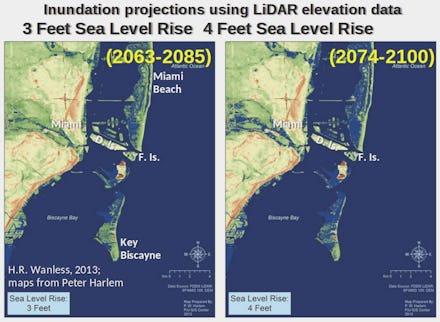This Is What Climate Change Is About to Do to Florida and New York

The news: Climate change might be hitting major metropolitan areas harder and sooner than you think. Two new reports show that Florida and New York are expected to have serious problems within the next few decades and may look totally different by the end of the century.
Florida: University of Miami professor and climate change expert Harold R. Wanless warns that ongoing construction in south Florida might be occurring in areas that will eventually be taken over by the ocean. NOAA's 2012 National Climate Assessment projects a rise of 4.1-6.6 feet in sea levels (1-2m) by 2100, reaching 2 feet by 2050 and 3 feet by 2075.
This kind of sea-level rise would render nearly all of the world's barrier islands uninhabitable and flood deltas where millions of people live. In Florida, stretches of prime tourist beaches will simply be swept away. What's more, Wanless writes, the current scientific understanding of rising seas indicates that ocean levels will actually rise in quick pulses rather than a slow-but-steady creep, making coastal flooding-preparations much mroe difficult.
These maps show projected sea levels over the next 84 years. Entire islands will be more or less destroyed.
None of these projections are good news. Key Biscayne, with a population of 12,334, will disappear and wash away millions of dollars in real estate value. The rest of the coast will likely face similar problems.
Wanless worries that Florida will not be adequately prepared for disaster. He writes that "for each day action is put off, it becomes harder and more expensive to make the inevitable changes required. Without planning, there will come a point where society will collapse into chaos."
New York: Future 100-year flood zones for New York City are expected to be severe. By 2050, nearly a quarter of the city could be flooded during a disastrous storm, with 114,000 buildings, 800,000 residents and 97% of the city's power-generating capabilities compromised.
A report issued in 2013 by the New York City Panel on Climate Change said that by the 2020s, annual temperatures for NYC will rise by two to three degrees on average, and the number of summer heat waves could increase from two to three or four. In 2050, temperatures will rise an average of 4-6.5 degrees, and the number of days over 90 may double. Water levels at the southern Manhattan Battery will rise 11-24 inches, with 31 inches less likely but possible. Eventually, large stretches of riverside and oceanfront New York property may need to be abandoned or retrofitted to even have a chance of withstanding the huge flooding.
If this doesn't sound like a pretty future, that's because it's not. Major changes to life on the coastline is just decades away, and even well-prepared locales like New York could still take major damage. Florida is way behind. And federal action is still remote, with an obstinate Congress still doing everything it can to block climate change-related legislation or even preparation.